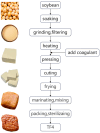Comparative Analysis of Texture Characteristics, Sensory Properties, and Volatile Components in Four Types of Marinated Tofu
- PMID: 38998575
- PMCID: PMC11241478
- DOI: 10.3390/foods13132068
Comparative Analysis of Texture Characteristics, Sensory Properties, and Volatile Components in Four Types of Marinated Tofu
Abstract
In this study, three different brands of commercially available marinated tofu were analyzed and compared with homemade products to explore the effect of key flavor substances on their sensory quality, sensory properties, texture characteristics, and volatile components. The texture characteristics and flavor substances of the three brands of commercially available marinated tofu were significantly different from those of homemade products. A total of 64 volatile components were identified by headspace-gas chromatography-ion mobility spectrometry (HS-GC-IMS), mainly including 11 hydrocarbons, 11 alcohols, 10 ketones, 15 aldehydes, 4 esters, 1 acid, and 12 other volatile substances. Among these, nine key flavor compounds (ROAV > 1, VIP > 1) were identified using the relative odor activity value (ROAV) combined with a partial least squares discriminant analysis (PLS-DA) and variable importance in projection, including α-Pinene, β-Myrcene, α-Phellandrene, 1-Penten-3-one, Butanal, 3-Methyl butanal, acetic acid ethyl ester, 1,8-Cineol, and 2-Pentyl furan. The correlation heatmap showed that sensory evaluation was positively correlated with hardness, gumminess, chewiness, and springiness while negatively correlated with 2-Pentyl furan, α-Pinene, resilience, α-Phellandrene, 1-Penten-3-one, acetic acid ethyl ester, and 1,8-Cineol. Overall, this study provides a theoretical reference for developing new instant marinated tofu snacks.
Keywords: HS-GC-IMS; PLS-DA; ROAV; key volatile flavor substance; marinated tofu.
Conflict of interest statement
The authors declare no conflicts of interest.
Figures











Similar articles
-
Characterization of the key flavor compounds in cream cheese by GC-MS, GC-IMS, sensory analysis and multivariable statistics.Curr Res Food Sci. 2024 May 17;8:100772. doi: 10.1016/j.crfs.2024.100772. eCollection 2024. Curr Res Food Sci. 2024. PMID: 38840807 Free PMC article.
-
Flavor Quality Analysis of Ten Actinidia arguta Fruits Based on High-Performance Liquid Chromatography and Headspace Gas Chromatography-Ion Mobility Spectrometry.Molecules. 2023 Nov 13;28(22):7559. doi: 10.3390/molecules28227559. Molecules. 2023. PMID: 38005281 Free PMC article.
-
Characterization of the flavor profile of Hulatang using GC-IMS coupled with sensory analysis.Front Nutr. 2024 Aug 29;11:1461224. doi: 10.3389/fnut.2024.1461224. eCollection 2024. Front Nutr. 2024. PMID: 39267861 Free PMC article.
-
Characterization of the Key Aroma Volatile Compounds in Nine Different Grape Varieties Wine by Headspace Gas Chromatography-Ion Mobility Spectrometry (HS-GC-IMS), Odor Activity Values (OAV) and Sensory Analysis.Foods. 2022 Sep 8;11(18):2767. doi: 10.3390/foods11182767. Foods. 2022. PMID: 36140895 Free PMC article.
-
Characterization of Key Compounds of Organic Acids and Aroma Volatiles in Fruits of Different Actinidia argute Resources Based on High-Performance Liquid Chromatography (HPLC) and Headspace Gas Chromatography-Ion Mobility Spectrometry (HS-GC-IMS).Foods. 2023 Sep 28;12(19):3615. doi: 10.3390/foods12193615. Foods. 2023. PMID: 37835267 Free PMC article.
Cited by
-
Comparative analysis of physicochemical properties, sensory characteristics, and volatile flavor compounds in five types of potato chips.Front Nutr. 2025 Mar 19;12:1525480. doi: 10.3389/fnut.2025.1525480. eCollection 2025. Front Nutr. 2025. PMID: 40177180 Free PMC article.
References
-
- Raja J., Punoo H.A., Masoodi F.A. Comparative study of soy paneer prepared from soymilk, blends of soymilk and skimmed milk. J. Food Process. Technol. 2014;5:1–5.
-
- Hendrich S. Nutritional, nutraceutical and functional properties of soybeans. Food Sci. Hum. Nutr. 2017;2:162.
LinkOut - more resources
Full Text Sources
Miscellaneous

